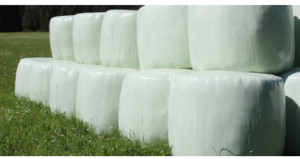In the vast expanse of Australia’s agricultural landscapes, hay production plays a critical role in sustaining livestock during periods of scarcity. As an essential component of feed, hay quality directly influences the health and productivity of livestock. However, hay is vulnerable to degradation caused by exposure to moisture, heat, and pests, particularly in the harsh climate conditions of Australia. To combat these challenges and preserve hay integrity, Australian farmers increasingly turn to a strong bale wrap as a reliable solution. In this article, we delve into the significance of bale wrap in safeguarding hay quality within the Australian climate.
Understanding the Challenges
 Australia’s diverse climate, characterised by extremes in temperature and precipitation, presents unique challenges for hay production and storage. From scorching summers to unpredictable rainfall patterns, farmers face constant pressure to protect harvested hay from environmental degradation. Exposure to moisture can lead to mould growth and nutrient loss, while prolonged sunlight exposure accelerates hay deterioration through bleaching and nutrient degradation. Additionally, pests such as rodents and insects pose a significant threat to stored hay, further compromising its quality.
Australia’s diverse climate, characterised by extremes in temperature and precipitation, presents unique challenges for hay production and storage. From scorching summers to unpredictable rainfall patterns, farmers face constant pressure to protect harvested hay from environmental degradation. Exposure to moisture can lead to mould growth and nutrient loss, while prolonged sunlight exposure accelerates hay deterioration through bleaching and nutrient degradation. Additionally, pests such as rodents and insects pose a significant threat to stored hay, further compromising its quality.
The Role of Bale Wrap
Bale wrap, also known as silage wrap or baleage film, serves as a protective barrier against the elements, preserving the nutritional value and freshness of hay. Made from high-quality polyethylene plastic, bale wrap forms a tight seal around individual bales, shielding them from moisture, sunlight, and pests. By creating an anaerobic environment, bale wrap inhibits mould growth and maintains hay quality over an extended period.
Benefits of the Australian Climate
In the Australian climate, where temperature fluctuations and moisture levels vary widely, a strong bale wrap offers several key benefits for hay preservation:
- Moisture Management: One of the primary advantages of bale wrap is its ability to prevent moisture ingress into hay bales. In regions prone to sporadic rainfall or high humidity, bale wrap acts as a waterproof barrier, reducing the risk of mould and nutrient leaching. By maintaining optimal moisture levels within the bale, farmers can ensure that their hay retains its nutritional value and palatability, even during prolonged storage.
- Sun Protection: Bale wrap effectively shields hay bales from UV radiation, which can degrade the nutritional content and colour of hay. By preventing sunlight exposure, bale wrap preserves the green colour and vitamin content of hay, ensuring that livestock receive high-quality feed throughout the year. This protection is particularly crucial in arid regions where intense sunlight can accelerate hay deterioration.
Best Practices for Bale Wrapping
While bale wrap offers significant benefits for hay preservation, proper installation and management are essential to maximise its effectiveness. Here are some best practices for bale wrapping in the Australian climate:
- Ensure Proper Sealing: Achieving a tight seal is critical to the success of bale wrapping. Properly overlap the edges of the bale wrap and apply sufficient tension to eliminate air pockets and create a secure seal. Any gaps or tears in the wrap can compromise its effectiveness, allowing moisture and pests to penetrate the bale.
- Monitor Moisture Levels: Regular monitoring of moisture levels within the bales is essential to prevent mould growth and nutrient loss. Use a moisture probe or handheld meter to assess moisture content periodically and adjust ventilation as needed to maintain optimal conditions.
- Store Bales on Elevated Ground: Placing bales on elevated ground or gravel pads helps prevent moisture absorption from the soil, reducing the risk of bottom spoilage. Ensure proper drainage to prevent water accumulation around the bales, especially during heavy rainfall or flooding events.
- Rotate Stockpile: Rotate hay stockpiles regularly to prevent spoilage and ensure even utilisation of feed reserves. Use older bales first to minimise storage losses and maintain hay quality over time.
In the challenging climate conditions of Australia, preserving hay quality is paramount for ensuring the health and productivity of livestock. A strong bale wrap emerges as a versatile and effective solution for protecting harvested hay from moisture, sunlight, and pests. By incorporating bale wrap into their hay production and storage practices, Australian farmers can prolong the shelf life of their hay, minimise losses, and ensure a consistent supply of high-quality feed for their livestock, even in the face of environmental challenges.

 Orangeline Polypropylene Baler Twine is a single-ply twine with 130 lb. of tensile strength and comes in a hi-visibility orange colour. This baling twine is designed for use in small square alfalfa, grass and straw balers and features UV stabilization that allows it to hold up to the elements. This baling twine has a smooth texture that prevents knots from slipping and reduces machine wear. Additionally, it is rot and mildew resistant, so you can leave it out for long periods without worrying about it getting brittle. This twine is also easy on the hands and does not have odours or tastes that would attract rodents. For more
Orangeline Polypropylene Baler Twine is a single-ply twine with 130 lb. of tensile strength and comes in a hi-visibility orange colour. This baling twine is designed for use in small square alfalfa, grass and straw balers and features UV stabilization that allows it to hold up to the elements. This baling twine has a smooth texture that prevents knots from slipping and reduces machine wear. Additionally, it is rot and mildew resistant, so you can leave it out for long periods without worrying about it getting brittle. This twine is also easy on the hands and does not have odours or tastes that would attract rodents. For more